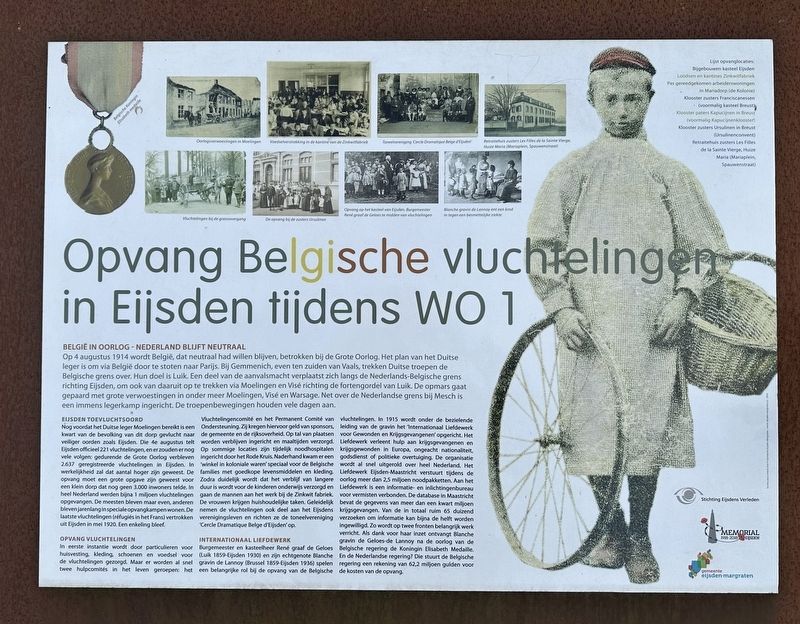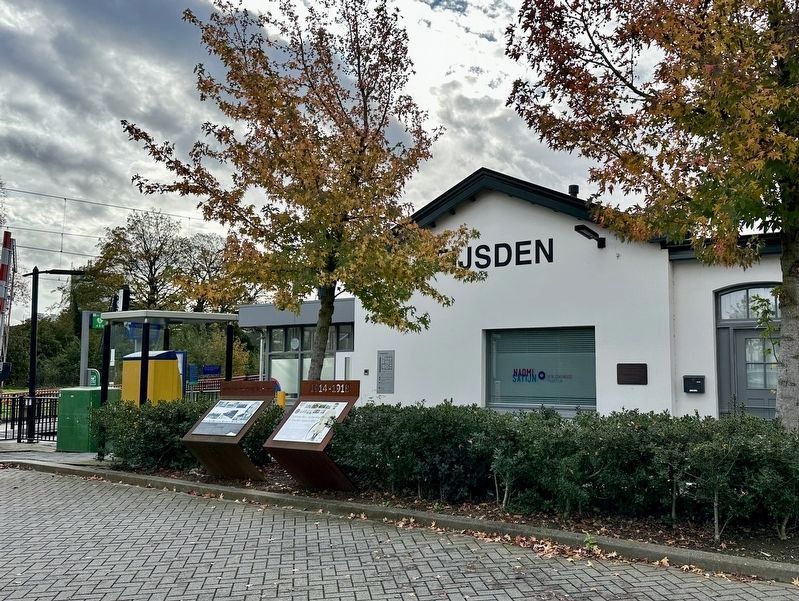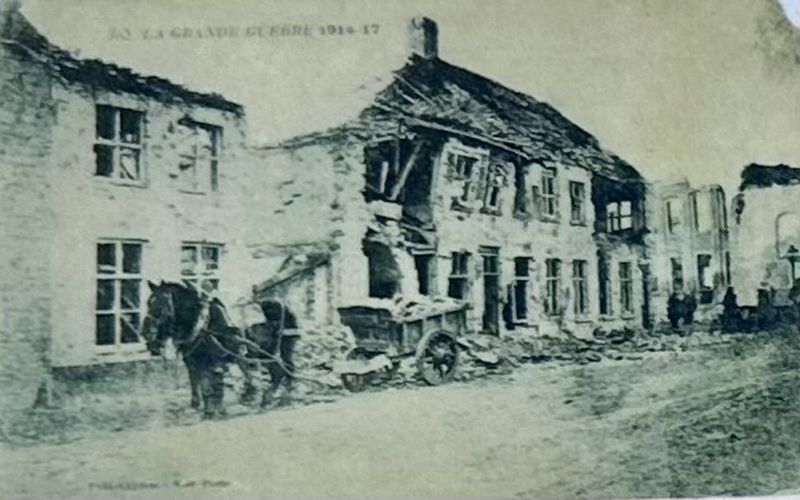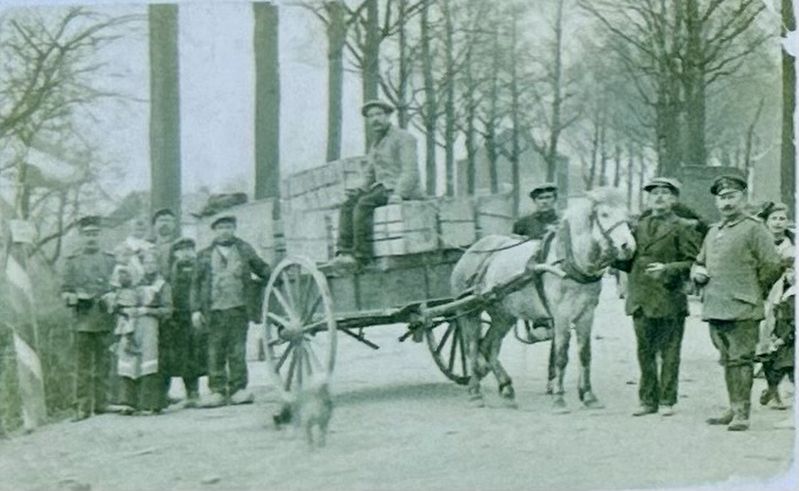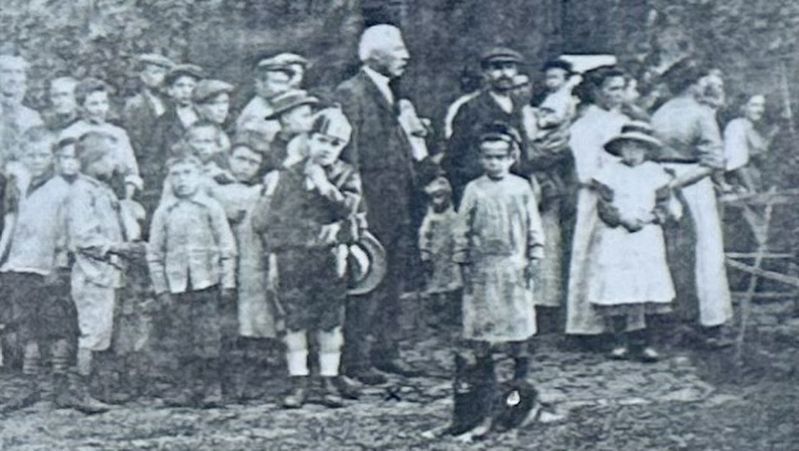Eijsden in Eijsden-Margraten, Limburg, Netherlands — Northwestern Europe
Opvang Belgische vluchtelingen / Asylum for Belgian Refugees
Inscription.
Opvang Belgische vluchtelingen in Eijsden tijdens WOI
België in Oorlog - Nederland Blijft Neutraal
Op 4 augustus 1914 wordt België, dat neutraal had willen blijven, betrokken bij de Grote Oorlog. Het plan van het Duitse leger is om via België door te stoten naar Parijs. Bij Gemmenich, even ten zuiden van Vaals, trekken Duitse troepen de Belgische grens over. Hun doel is Luik. Een deel van de aanvalsmacht verplaatst zich langs de Nederlands-Belgische grens richting Eijsden, om ook van daaruit op te trekken via Moelingen en Visé richting de fortengordel van Luik. De opmars gaat gepaard met grote verwoestingen in onder meer Moelingen, Visé en Warsage. Net over de Nederlandse grens bij Mesch is een immens legerkamp ingericht. De troepenbewegingen houden vele dagen aan.
Eijsden Toevluchtsoord
Nog voordat het Duitse leger Moelingen bereikt is een kwart van de bevolking van dit dorp gevlucht naar veiliger oorden zoals Eijsden. Die 4e augustus telt Eijsden officieel 221 vluchtelingen, en er zouden er nog vele volgen: gedurende de Grote Oorlog verbleven 2.637 geregistreerde vluchtelingen in Eijsden. In werkelijkheid zal dat aantal hoger zijn geweest. De opvang moet een grote opgave zijn geweest voor een klein dorp dat nog geen 3.000 inwoners telde. In heel Nederland werden bijna 1 miljoen vluchtelingen opgevangen. De meesten bleven maar even, anderen bleven jarenlang in speciale opvangkampen wonen. De laatste vluchtelingen (réfugiés in het Frans) vertrokken uit Eijsden in mei 1920. Een enkeling bleef.
Opvang Vluchtelingen
In eerste instantie wordt door particulieren voor huisvesting, kleding, schoenen en voedsel voor de vluchtelingen gezorgd. Maar er worden al snel twee hulpcomités in het leven geroepen: het Vluchtelingencomité en het Permanent Comité van Ondersteuning. Zij kregen hiervoor geld van sponsors, de gemeente en de rijksoverheid. Op tal van plaatsen worden verblijven ingericht en maaltijden verzorgd. Op sommige locaties zijn tijdelijk noodhospitalen ingericht door het Rode Kruis. Naderhand kwam er een winkel in koloniale waren' speciaal voor de Belgische families met goedkope levensmiddelen en kleding. Zodra duidelijk wordt dat het verblijf van langere duur is wordt voor de kinderen onderwijs verzorgd en gaan de mannen aan het werk bij de Zinkwit fabriek. De vrouwen krijgen huishoudelijke taken. Geleidelijk nemen de vluchtelingen ook deel aan het Eijsdens verenigingsleven en richten ze de toneelvereniging 'Cercle
Dramatique Belge d'Eijsden' op.
Internationaal Liefdewerk
Burgemeester en kasteelheer René graaf de Geloes (Luik 1859-Eijsden 1930) en zijn echtgenote Blanche gravin de Lannoy (Brussel 1859-Eijsden 1936) spelen een belangrijke rol bij de opvang van de Belgische vluchtelingen. In 1915 wordt onder de bezielende leiding van de gravin het 'Internationaal Liefdewerk voor Gewonden en Krijgsgevangenen' opgericht. Het Liefdewerk verleent hulp aan krijgsgevangenen en krijgsgewonden in Europa, ongeacht nationaliteit, godsdienst of politieke overtuiging. De organisatie wordt al snel uitgerold over heel Nederland. Het Liefdewerk Eijsden-Maastricht verstuurt tijdens de oorlog meer dan 2,5 miljoen noodpakketten. Aan het Liefdewerk is een informatie- en inlichtingenbureau voor vermisten verbonden. De database in Maastricht bevat de gegevens van meer dan een kwart miljoen krijgsgevangen. Van de in totaal ruim 65 duizend verzoeken om informatie kan bijna de helft worden ingewilligd. Zo wordt op twee fronten belangrijk werk verricht. Als dank voor haar inzet ontvangt Blanche gravin de Geloes-de Lannoy na de oorlog van de Belgische regering de Koningin Elisabeth Medaille. En de Nederlandse regering? Die stuurt de Belgische regering een rekening van 62,2 miljoen gulden voor de kosten van de opvang.
Asylum for Belgian Refugees in Eijsden in WWI
Belgium at War - Netherlands Remains Neutral
On August 4, 1914, Belgium, which had wanted to remain neutral, became involved in the Great War. The German army's plan was to advance to Paris via Belgium. At Gemmenich, just south of Vaals, German troops crossed the Belgian border. Their goal is Liège. Part of the attack force moved along the Dutch-Belgian border towards Eijsden, and from there it also advanced via Moelingen and Visé towards the fortress belt of Liège. The advance is accompanied by major destruction in Moelingen, Visé and Warsage, among others. An immense army camp has was set up just across the Dutch border from Mesch. The troop movements continue for many days.
Refuge in Eijsden
Even before the German army reached Moelingen, a quarter of the population of this village fled to safer places such as Eijsden. On August 4, Eijsden officially had 221 refugees, and many more would follow: during the Great War, 2,637 registered refugees stayed in Eijsden. In reality, that number would have been higher. The shelter must have been a major challenge for a small village with fewer than 3,000 inhabitants. Nearly 1 million refugees were received throughout the Netherlands. Most only stayed for a short time, others lived in special reception camps for years. The last refugees (réfugiés in French) left Eijsden in May 1920. A few stayed.
Shelter for refugees
Initially, private individuals provided housing, clothing, shoes and food for the refugees. But two relief committees were soon created: the Refugee Committee and the Standing Support Committee. They received money for this from sponsors, the municipality and the central government. Accommodations were furnished and meals were provided in many places. Temporary emergency hospitals have been set up by the Red Cross in some locations. Afterwards, a shop selling colonial goods was opened, especially for Belgian families, with cheap food and clothing. As soon as it became clear that the stay will be for a longer period, education was provided for the children and the men went to work at the Zinkwit factory. The women are given household duties. The refugees gradually also participate in Eijsden's club life and establish the theater association 'Cercle Dramatique Belge d'Eijsden'.
International Relief Work
Mayor and lord of the castle René Count de Geloes (Liège 1859-Eijsden 1930) and his wife Blanche Countess de Lannoy (Brussels 1859-Eijsden 1936) played an important role in the reception of Belgian refugees. In 1915, the 'International Charity for Wounded and Prisoners of War' was founded under the inspiring leadership of the Countess. The Work of Charity provides assistance to prisoners of war and war wounded in Europe, regardless of nationality, religion or political belief. The organization would soon be rolled out throughout the Netherlands. The Charity Eijsden-Maastricht sent more than 2.5 million emergency packages during the war. An information and intelligence agency for missing persons was associated with the relief efforts. The database in Maastricht contained the details of more than a quarter of a million prisoners of war. Of the more than 65,000 requests for information, almost half could be fulfilled. Important work was being done on two fronts. In gratitude for her efforts, Blanche Countess de Geloes-de Lannoy received the Queen Elisabeth Medal from the Belgian government after the war. And the Dutch government? It sent the Belgian government a bill of 62.2 million guilders for the costs of shelter.
Erected by Gemeente Eijsden-Margraten, Stichting Eijsdens Verleden, Memorial Eijsden.
Topics. This historical marker is listed in these topic lists: Immigration • War, World I. A significant historical date for this entry is August 4, 1914.
Location. 50° 46.335′ N, 5° 42.593′ E. Marker is in Eijsden, Limburg, in Eijsden-Margraten. Marker is on Stationsplein, on the left when traveling south. Touch for map. Marker is at or near this postal address: Stationsplein 9, Eijsden, Limburg 6245 AE, Netherlands. Touch for directions.
Other nearby markers. At least 8 other markers are within walking distance of this marker. De Vlucht van Keizer Wilhelm II / The Flight of Kaiser Wilhelm II (here, next to this marker); Martin H. Wolfs Memorial (a few steps from this marker); Het Veldje / The Field (approx. 0.3 kilometers away); Von Dorpsstraat tot Diepstraat / From Dorpsstraat to Diepstraat (approx. 0.6 kilometers away); Aan de Laak / At the Border Water (approx. 0.6 kilometers away); Petrus Wolfs (approx. 0.8 kilometers away); Eijsden - Gronsveld Holocaust Memorial - De Breuk (“The Break”) (approx. 0.8 kilometers away); Verzetsmonument Eijsden / Resistance Memorial Eijsden (approx. 0.8 kilometers away). Touch for a list and map of all markers in Eijsden.
Credits. This page was last revised on January 26, 2024. It was originally submitted on January 26, 2024, by Andrew Ruppenstein of Lamorinda, California. This page has been viewed 44 times since then. Photos: 1, 2, 3, 4, 5. submitted on January 26, 2024, by Andrew Ruppenstein of Lamorinda, California.
